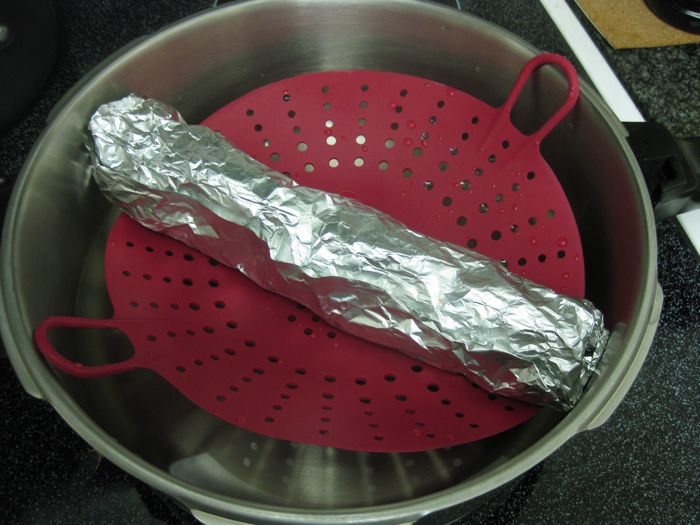Last month my cousin Nancy was in town and we went to meet up with my brother and his wife for dinner at Ichiumi, a buffet place in Edison, NJ. There was a huge selection of food including lots of seafood items of varying degrees of quality. I spotted one of my favorite things to eat- monkfish liver (also known as ankimo in Japanese), so I of course had to sample it. Sadly, it was awful. Probably the worst I’ve ever tasted. It had a very strong fishy funkiness to it and strands of sinewy veins which ruined the texture. Monkfish liver is supposed to be a little bit funky in a liver-ish sort of way, but mildly so and with a totally smooth texture. It has been called the foie gras of the sea and for good reason. When prepared correctly it has a mouth-filling richness and a mellow creaminess that exemplifies decadence.
The preparation of monkfish liver isn’t particularly difficult, so let me show you how I do it at home. First, get some raw monkfish liver from a reputable fishmonger or Japanese market. Usually monkfish liver is best during the cold weather months, so if this is your first time trying it out, now is a good time for it. It should be a nice pale cream color with as few red spots as possible. The good stuff, partially pre-cleaned for you, should run about $10 a pound. If it’s significantly cheaper than that, I’d probably steer clear of it. When you get it home, the first thing to do is to sprinkle some salt all over it, then place it in a bowl and pour in just enough sake to cover it. It can be any cheap sake, just avoid the sweet or cloudy unfiltered varieties. Here’s what good quality monkfish liver looks like at this stage of the preparation:

Place the bowl in the refrigerator to let it soak for an hour. This is the first step that Ichiumi must have botched because the salt and sake is what draws out the overwhelming funkiness.
After an hour, dump out the sake and place your liver on a cutting board. This is the only mildly challenging/messy part of the process. With a very sharp knife, start trying to remove any veins or sinewy strands that you see. Anything that does not look like soft liver tissue should be removed, so that includes the very thin outer membrane which peels away very easily once you get it started. The veins are often impossible to remove in complete strands, so don’t don’t get frustrated if you have to remove little pieces at a time. Try to pull the veins off the liver and then use your knife to gently scrape the liver away from them. It will look something like this:

As you proceed, you will be exposing more and more of the interior of the liver. That allows you to run your fingers thru it looking for any other tough strands. Also cut away any red blood spots that you see. Don’t worry if it looks like you’re completely mangling the poor piece of liver and it ends up looking like little mounds of jello on your cutting board. In fact, you actually want it broken down into smaller blobs like that because that will make the subsequent rolling step much easier.
Once you have the liver completely deveined, transfer it onto a sheet of heavy duty aluminum foil. Place it all in a horizontal row at the edge of the foil closest to you. Then grab that edge of the foil and gently lift it up and roll it forward, trying to encase the liver into a little tube shape. Do your best to get the liver into as tight a roll as possible without it squeezing out of the two ends. Once you have completed your little aluminum liver tube package, place it into a pan with a steamer rack and let it steam for 30 minutes:

After 30 minutes, take it out, let it cool down and then refrigerate until you want to serve it. To serve, just unroll the package and slice off coins about 1/4″ thick. I like to place them in a bowl with a little bit of scallion and drizzle them with ponzu soy (a sauce made of soy sauce and ponzu juice, it’s not as salty as soy sauce and has a citrus flavor that helps cut the richness of the liver). And a quick tip regarding the scallions- for any recipe that calls for raw scallion, I like to use a technique I first learned by watching the guys at Typhoon in the East Village. Finely slice the scallions, wash them in really cold water, and then drain and dry them in paper towels to get out the extra moisture. This cuts the aggressiveness of the oniony flavor and just makes them more palatable overall. If you want to get really fancy with your monkfish liver preparation, a little dab of momiji oroshi would go fantastically with it. That’s the spicy grated daikon that you’ll see with some dishes at Japanese restaurants. Alas, I didn’t make any of that this time around, so here’s my simply plated finished dish:

Awesome, looks delicious. Monkfish is actually my fave app at the jap restuarant I goto. I just had it on tues. Yummy.
Hmm….marinating raw liver in alcohol and salt makes it taste sweeter? Our livers would be delicious!!
lol, I’m pretty sure my liver would probably be like foie gras!
I am not a liver fan, as you well know, yet every preparation that you describe to me or write about makes my mouth water. This really looks fantastic!